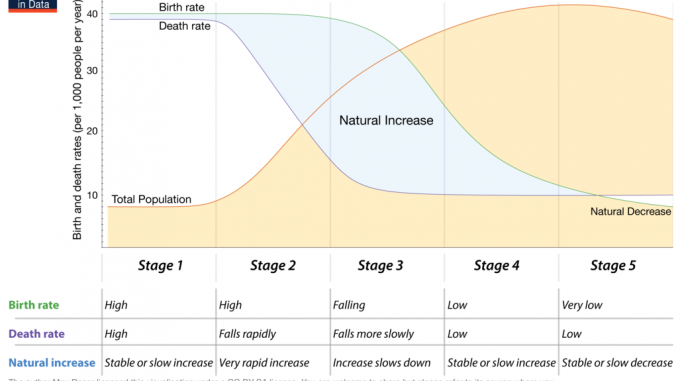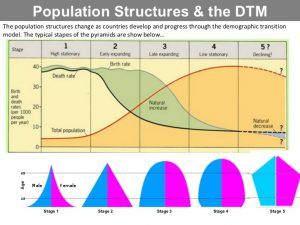
Demographic Transition Theory
- The word ‘Demography’ came from the prefix ‘demo’ meaning people and ‘graphy’ meaning description or measurement. Similarly, ‘transition’ means process of changing from one state to another
- So, the phrase ‘Demographic Transition Theory’ clearly reflects from the name itself that it is a theory/model which describes the population change that occurs over a period of time
- Demographic Transition is a gradual process in which a society moves from high birth rate and death rate to low birth rate and death rate
- It deals with population change occurring from the past to the change that may occur in future
- Furthermore, the theory shows the transition of population from high birth and death rate to low birth and death rate as the country (or any region) moves from pre-industrial era to an industrialized era. Thus the major emphasis of the theory is given to the economic development which results in change in population
- The theory was 1st propounded and interpreted by an American demographer Warren Thompson who saw changes in the population pattern all over the world in due course of time
- It looks at three major indicators for assessing and predicting population change: fertility, mortality and growth rate
- There are usually 4-5 stages for categorizing demographic transition. This is because earlier categorization was done in 4 stages. However, with the change in population pattern which could not be addressed by 4 stages, a new 5th stage has been added to it.
- Here we have explained this theory considering all 5 stages. Stages of demographic transition are described below:
- High Stationary Stage
- The stage before industrial revolution. Also known as Pre-transition phase
- The country or region in this stage are characterized by high fertility (birth rate) and high mortality (death rate)
- This stage has low or stable growth rate i.e. population remains constant due to high birth and death rate
- Reasons for high birth rate were: lack of family planning methods, high infant mortality rate convincing couples to have more babies, more family members = more source of economic assets
- Reasons for high mortality rate were: poor health and health services, famine, lack of proper education and unavailability of clean water and sanitation
- Relatively low people in older age
2. Early expanding phase
- In this stage, birth rate keeps on increasing while death rates begin to fall rapidly/sharply. This results in high/rapid population growth
- It is also known as population explosion stage
- Reasons for decline in death rates were: increase in food supply due to agricultural revolution and improvement in health and sanitation causing reduction in child mortality
- High birth rate results in larger cohort of younger population
- Most of the least developed countries are in this stage
3. Late expanding phase
- In this stage the birth rate also starts to fall/decrease
- However, the major point is that, while birth rate starts to decrease slowly and gradually, death rate also keeps on falling slowly. This leads to the narrowed gap between birth and death rate compared to early expanding stage
- Result of this stage is low population growth or natural increase in population
- Reasons for gradual decrease in birth rates were: the introduction of contraceptive devices, increase in women’s status and rise in economic conditions and education level of the people
- Most of the developing countries are in this stage
4. Low stationary/low fluctuating stage
- It is known as the stage of stationary population
- In this stage, birth rates and death rates both are low. Also both of them are approximately equal to each other
- This results in stability/slow rise in population
- Most of the developed countries are in this stage
5. Declining Phase
- This stage is characterized by low death rate, lower birth rate and excess deaths over births
- In this stage birth rates are below death rates i.e. fertility rate is below the replacement level (2 children). This leads to increase in dependent/elderly population compared to the younger populations
- This stage is resulted due to continuous desire of the families to have a smaller family
- Some parts of Europe like Russia, Sweden and Germany and Japan are reaching towards this stage

Strengths/Uses of this theory
- Based on actual population growth trend of the countries of the world
- Universal applicability i.e. Applicable to both developing and developed countries
- Allows comparison between the countries
Disadvantages/limitations of this theory
- The theory is accused of being Eurocentric i.e. following the trend of European countries. This is because all the countries may not follow the same stages of population transition. Also, results might be different in cases of countries going through war as they are less likely to experience industrialization
- It does not consider the impact of migration as countries like USA and Canada experienced migration from European regions and did not have to pass through earlier stages
- The model cannot predict how long any country will remain in a certain stage
References
http://pages.uwc.edu/keith.montgomery/Demotrans/demtran.htm
https://www.populationeducation.org/content/what-demographic-transition-model
http://papp.iussp.org/sessions/papp101_s01/PAPP101_s01_090_010.html
https://www.ncbi.nlm.nih.gov/pmc/articles/PMC2781829/
http://study.com/academy/lesson/what-is-demographic-transition-definition-stages.html
http://shrinking.ums-riate.fr/Ressources/Chap_01/KIR_96.pdf
https://www.thoughtco.com/demographic-transition-geography-1434497
http://www.yourarticlelibrary.com/population/the-theory-of-demographic-transition-population/10895/
https://geographyas.info/population/demographic-transition-model/
http://www.economicsdiscussion.net/population/theory-of-demographic-transition-with-diagram/4479
http://cgge.aag.org/PopulationandNaturalResources1e/CF_PopNatRes_Jan10/CF_PopNatRes_Jan106.html
http://geographyfieldwork.com/DemographicTransition.htm
http://www.economie.ens.fr/IMG/pdf/lee_2003.pdf
http://www.yourarticlelibrary.com/population/the-theory-of-demographic-transition-population/10895/
http://www.yourarticlelibrary.com/notes/useful-notes-on-the-theory-of-demographic-transition/39637/
http://study.com/academy/lesson/demographic-transition-theory-definition-examples.html
http://www.tandfonline.com/doi/abs/10.1080/0032472031000149536
http://study.com/academy/lesson/the-theory-of-demographic-transition-overview.html
http://study.com/academy/lesson/the-theory-of-demographic-transition-overview.html
https://www.ncbi.nlm.nih.gov/pubmed/11618374
https://www.slideshare.net/lie8989/demographic-transition-theory
https://link.springer.com/referenceworkentry/10.1007%2F978-0-387-33754-8_123#page-1